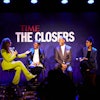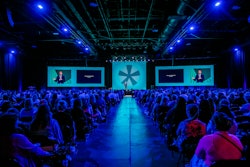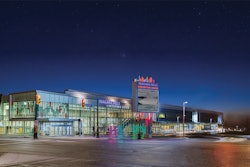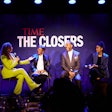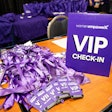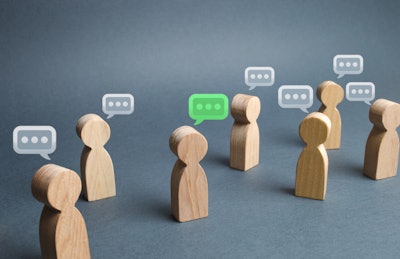
When San Francisco-based experiential marketing agency DPEM was building a recent experience for Toyota and its Scion brand, the team took a slightly unconventional approach to the planning process: They used internet chat rooms.
“We thought, ‘Let’s not be talking at people who know more about this than we do. Let’s let them actually design the party,” remembers DPEM founder and chief visionary officer Dominic Phillips. “We went into chat rooms for Scion owners and just listened for a while before saying, ‘Scion commissioned us to do an event, and we’re super excited to find out what you would want.’"
"We ended up creating this community within the chat rooms of people that were excited to add their two cents to the event," he says.
The members of the chat room who contributed ideas were given an invite link to the event, and encouraged to invite others. “So we actually allowed them to become ambassadors for what we were doing,” Phillips explains. “And the turnout was incredible—because it wasn't just the people who already knew about Scion; there was a whole group of people that didn't know anything about Scion. Ultimately, the marketing goal here was outreach—and we achieved it through actually being interested in what the audience wanted.”
The DPEM team also took care during the process to acknowledge and thank people for their ideas. “It was about not just asking people for something, which is very one-directional, but instead thinking about the request as a form of engagement,” Phillips says. “How do we create that relationship? How do we ask you for something in a way that makes you feel that you can see the results, and everybody is aware that it’s your great idea?”  On-site at the Toyota event (pictured), those who had contributed ideas were thanked in fun ways, with areas named things like “Bob’s Super Lounge” or “Joe’s Playstation.” Those who had contributed ideas were also invited to a separate “influencer event” within the larger gathering, giving them a sense of social currency that made them even more invested in this event and future events from the brand.Photo: Courtesy of DPEM
On-site at the Toyota event (pictured), those who had contributed ideas were thanked in fun ways, with areas named things like “Bob’s Super Lounge” or “Joe’s Playstation.” Those who had contributed ideas were also invited to a separate “influencer event” within the larger gathering, giving them a sense of social currency that made them even more invested in this event and future events from the brand.Photo: Courtesy of DPEM
Phillips sees the Toyota event as a great example of why it’s crucial to incorporate your audience into the planning process—and why the idea extends beyond a simple survey. “A lot of times, planners will see [surveys and other feedback] as checking something off the list—but actually it's really about intent. It's about how you perceive an experience, and how you invest in it,” he says.
We asked Phillips and other event professionals how they effectively seek both pre- and post-event feedback from their audiences—and what pitfalls they try to avoid. Read on for their useful tips.
1. Think through the most effective ways to connect with your specific audience.
Not all audiences are created equal—and neither are the best ways to gather their feedback. “In every situation with marketing—and I see a questionnaire as marketing—you have to know who you're sending it to and exactly what you're looking to get back from them," Phillips notes. "Every time you connect with a potential audience is a touch point. It's part of the attendee journey."
As with the Toyota event, Phillips suggests going to Instagram pages, Reddit threads, LinkedIn groups, and more, and simply asking potential attendees for their opinions. "By asking people what they think, we are really connecting them with who we are as a brand and the event we're trying to create," he says, adding that this process should be tailored to each specific audience. "So if it’s 3,000 meeting attendees versus 30,000 people going to a music concert, the way we speak to them is going to be different. We’re going to look at different channels."
Andrew Roby, the founder of Andrew Roby Events in Washington, D.C., takes a similar approach, which he calls "indirect crowd-sourcing"—and it doesn't always have to come directly from attendees. "Get on social media and just watch conversations and take notes," he suggests. "You find so much inside Facebook groups with common/routine questions that are always asked. [Or,] even asking vendors on the trade show floor what common questions they answer helps feed into crowd-sourcing."
It's all about creating community around the event, says Beth Lawrence, chief experience officer at Beth Lawrence Meetings & Events in Philadelphia. "For example, if you are planning a first-time event for a membership-based, remote organization, it's typically a great idea to distribute pre-event surveys, use polls in your social media and online presence, and build polling into other Zoom sessions throughout the year," she explains.
Keeping in touch with potential attendees throughout the year can also help you design programming and events that are in line with their needs at that particular time, Lawrence adds. "You can do this in overt ways (like a pre-program survey) and covert ways (like a digital community where folks are encouraged to share with, and learn from, their peers)."
2. Carefully consider your questions, and keep them open-ended.
As for the right questions to ask, Phillips advises against simple yes-no questions—instead, he suggests leaning into open-ended questions. While it may take more time for your team to analyze the answers, it allows guests to respond with the information they actually care about.
But keep it short and interactive, he advises. “If you say there's only going to be, say, three questions, people won’t be overwhelmed by it,” Phillips notes, adding that thinking creatively can also increase engagement. “Maybe it’s a video experience, where the head of events says, ‘It means so much that you can be a part of this community. We want to evolve this experience. Here are three questions we’d love to ask you.’”
Phillips also suggests crafting questions about the health of the event, rather than about the specifics of the event. “Questions like, 'Did you like the food, was the AV OK, how was the temperature’—honestly, no one is going to remember that stuff,” he argues. “What they will remember is, ‘How did you feel? Did this event speak to your interests? What would make it more beneficial for you? How did you hear about this event so we can deliver you more information in that same channel?'"
Roby suggests similarly open-ended questions, and often likes to ask them directly on registration forms. “We ask questions such as ‘What pain point do you require immediate support on?’ or ‘What subject do you find fascinating and want to know more about?’” he says. “We also take advantage of exit polls with questions like, ‘What did the event lack in programming that you wished it had?’ and ‘What session do you feel needed more time?’”
 “Benefit Cosmetics is another company we work with, and they work very heavily with influencers. So we ask the influencers what's important to them," Phillips says. "How is our brand doing, what do you think needs to happen to keep it fresh, what do you like to see in these experiences that really gets you connected with the product?”Photo: Courtesy of DPEM
“Benefit Cosmetics is another company we work with, and they work very heavily with influencers. So we ask the influencers what's important to them," Phillips says. "How is our brand doing, what do you think needs to happen to keep it fresh, what do you like to see in these experiences that really gets you connected with the product?”Photo: Courtesy of DPEM
As for pre- or post-event surveys, Phillips thinks that timing depends on the type of event. If you’re looking for very specific feedback, he suggests offering a questionnaire on-site, perhaps taped under guests’ seats. “Have the person presenting explain why it’s so important,” he says. “Tell them to look under their seats, and if they have a gold star, there’s something amazing waiting for them—but of course, they have to do the questionnaire to get it. Make it fun and silly.”
But be aware: Post-event surveys can often turn into a place for people to vent. “So it’s critical that you allow for a vent to happen prior, almost like a pressure valve," Phillips explains. "You give people an opportunity to get rid of all of that frustration beforehand, because what you're looking for is something constructive.”
After an event, Phillips advises sending a survey within a week to 10 days. Before an event, meanwhile, he suggests doing it before tickets go on sale or when registration opens. Or, for something like an internal sales kick-off, have managers ask their teams what they’re looking for this year—before you even begin the planning process. “In that process of asking those people, you don't just get valuable information, but people feel that you're interested in them,” he points out. “And it goes beyond a simple event—it goes to creating an anticipation of value to it.”
For certain events, it’s also possible to shape your content in real time with what Lawrence calls a “non-con” session. “In these sessions, speakers crowdsource ideas on the spot from the audience. The audience votes on the topics, and when a final subject matter is chosen, the speakers have a certain amount of time (typically 5-10 minutes) to put together an informative presentation,” she explains. “This is a great way to boost attendee engagement on-site and fill in any content gaps in your programming.”
4. Incentivize people to share feedback.
"Incentives are a great way to ensure your attendees answer the surveys—from on-site upgrades to free or discounted tickets,” Lawrence notes.
Other incentives can incorporate things that are important to your audience. For example, “If it's around the holidays, then maybe say, 'For the goodwill of all and making sure this event is doing good, we’ve decided to do a charitable donation. And what we're looking for from you is to answer these three questions and tell us which charity you would like the money to go to,'" Phillips says.
Another idea? Be more targeted with who you solicit feedback and advice from. “Instead of sending a questionnaire to everybody and getting 5% to respond, you send emails directly to a handful of people," Phillips suggests. "Maybe it's 100 people, and we say, ‘We are interested in what you have to say, and we would love to invite you to participate in this influencer experience. … You’re building it in such a way that people want to be a part of it.”
5. Make sure to leave room for surprises.
Of course, don't lean so hard on crowd-sourced content and experiences that your guests know exactly what to expect, Roby advises. "Attendees come to events to learn what it is they don't know they don't know. Many times they seek experts to educate them on this—so if all of your content is crowd-sourced, you may fail to further advance the industry—you are keeping people at the current level versus pushing them forward," he points out.
6. Above all, make sure attendees know how much you value their feedback.
Roby finds that crowd-sourcing content and ideas is a great way to ensure audiences get as much value as possible out of an event. "The power is in the hands of attendees, as they are extremely picky about where they will invest their dollars and time," he says.
Phillips agrees. “I think COVID was an incredibly constructive experience in a professional way. It's made us really value value," he says. "What do we want to do with our time? How do we want to relate to one another? So the lesson from that is to create community. Know what your message is, and what you want to know from these [attendees]. Know exactly who they are, and then you can construct something that reflects the value you're putting in them.”
Beyond just crafting an event that's worth their time, though, Phillips thinks publicly acknowledging and thanking attendees for their contributions can go a long way—like his team did for the Toyota event, where those who had contributed ideas were invited to a special influencer gathering and even had certain areas of the event named after them.
In summary: “Take your time, learn from your people, and then build an experience that reflects them," Phillips says. "These are all the most influential people that are going to make a real difference in your event.”



